Checking tires
Check if the treadwear indicators are showing on the tires. Also check the tires for uneven wear, such as excessive wear on one side of the tread.
Check the spare tire condition and pressure if not rotated.
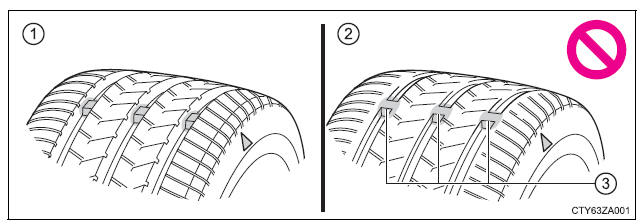
The location of treadwear indicators is shown by a "TWI" or " "
mark,
etc., molded into the sidewall of each tire.
"
mark,
etc., molded into the sidewall of each tire.
Replace the tires if the treadwear indicators are showing on a tire.
Tire rotation
Rotate the tires in the order shown.
To equalize tire wear and extend tire life, Toyota recommends that tire rotation is carried out at the same interval as tire inspection.
Do not fail to initialize the tire pressure warning system after tire rotation.
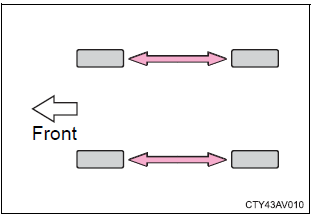
Tire pressure warning system
Your vehicle is equipped with a tire pressure warning system that uses tire pressure warning valve and transmitters to detect low tire inflation pressure before serious problems arise.
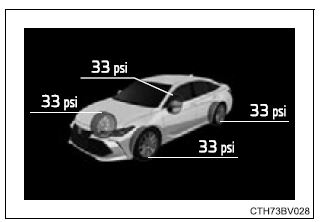

Installing tire pressure warning valve and transmitters
When replacing the tires or wheels, the tire pressure warning valve and transmitters must be installed to the wheels which will be installed to the vehicle.
When new tire pressure warning valve and transmitters are installed, new ID codes must be registered in the tire pressure warning computer and the tire pressure warning system must be initialized.
Initializing the tire pressure warning system
â– The tire pressure warning system must be initialized in the following circumstances:
When the tire pressure warning system is initialized, the current tire inflation pressure is set as the benchmark pressure.
â– How to initialize the tire pressure warning system
1. Park the vehicle in a safe place and turn the engine switch off.
The initialization procedure cannot be started while the vehicle is moving.
2. Adjust the tire inflation pressure to the specified cold tire inflation pressure level.
Make sure to adjust the tire pressure to the specified cold tire inflation pressure level. The tire pressure warning system will operate based on this pressure level.
3. Start the engine.
4. Select  on the
multi-information display using the meter control
switches on the steering wheel.
on the
multi-information display using the meter control
switches on the steering wheel.
5. Select  and then press and hold
and then press and hold  .
.
6. Select "TPWS" and then press  .
.
7. Select "Set Pressure" then
press and hold  until
the tire pressure warning
light blinks 3 times.
until
the tire pressure warning
light blinks 3 times.
Then a message will be displayed on the multi-information display.
"---" will be displayed on the multi-information display for the inflation pressure of each tire while initialization is being performed.
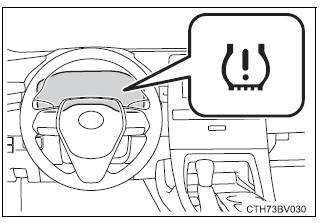
8. Drive straight (with occasional left and right turns) at approximately 25 mph (40 km/h) or more for approximately 10 to 30 minutes.
Initialization is complete when the position of each tire is determined and the inflation pressure of each tire is displayed on the multi-information display.
Initialization may take longer than approximately 1 hour in certain situations, such as when the vehicle is stopped for a long time at traffic lights, etc.
Registering ID codes
Every tire pressure warning valve and transmitter has a unique ID code. When replacing a tire pressure warning valve and transmitter, it is necessary to register the ID codes.
The ID codes can be registered on  of the multi-information display.
of the multi-information display.
â– How to register the ID codes
1. Select  on the
multi-information display using the meter control
switches on the steering wheel.
on the
multi-information display using the meter control
switches on the steering wheel.
2. Select  and then press and
hold
and then press and
hold  .
.
3. Select "TPWS" and then press  .
.
4. Select "Change Wheel" then
press and hold  until
the tire pressure warning
light blinks slowly 3 times.
until
the tire pressure warning
light blinks slowly 3 times.
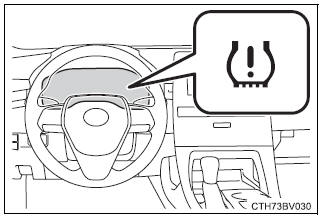
Then a message will be displayed on the multi-information display.
When registration is being performed, the tire pressure warning light will blink for approximately 1 minute then illuminate and "---" will be displayed for the inflation pressure of each tire on the multi-information display.
5. Drive straight (with occasional left and right turns) at approximately 25 mph (40 km/h) or more for approximately 10 to 30 minutes.
Registration is complete when the tire pressure warning light turns off and the inflation pressure of each tire is displayed on the multi-information display.
Registration may take longer than approximately 1 hour in certain situations, such as when the vehicle is stopped for a long time at traffic lights, etc.
After registering the ID codes, make sure to initialize the tire pressure warning system.
â– When to replace your vehicle's tires
Tires should be replaced if:
If you are not sure, consult with your Toyota dealer.
â– Replacing tires and wheels If the ID codes of the tire pressure warning valve and transmitters are not registered, the tire pressure warning system will not work properly. In this case, after driving for about 20 minutes, the tire pressure warning light will blink for approximately 1 minute and then illuminate to indicate a system malfunction.
â– Tire life Any tire over 6 years old must be checked by a qualified technician even if it has seldom or never been used or damage is not obvious.
â– Routine tire inflation pressure checks The tire pressure warning system does not replace routine tire inflation pressure checks. Make sure to check tire inflation pressure as part of your routine of daily vehicle checks.
â– Low profile tires (vehicles with 18 or 19-inch wheels) Generally, low profile tires will wear more rapidly and tire grip performance will be reduced on snowy and/or icy roads when compared to standard tires. Be sure to use snow tires on snowy and/or icy roads and drive carefully at a speed appropriate for road and weather conditions.
â– Maximum load of tire Check that the maximum load of the replacement tire is greater than 1/2 of the Gross Axle Weight Ratings (GAWR) of either the front axle or the rear axle, whichever is greater.
For the GAWR, see the Certification Label. For the maximum load of the tire, see the load limit at maximum cold tire inflation pressure mentioned on the sidewall of the tire.
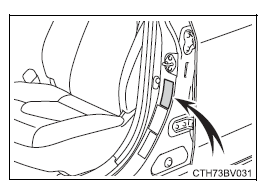
â– Tire types
â– If the tread on snow tires wears down below 0.16 in. (4 mm) The effectiveness of the tires as snow tires is lost.
â– Situations in which the tire pressure warning system may not operate properly
If tire position information is not correctly displayed due to the radio wave conditions, the display may be corrected by changing the location of the vehicle as the radio wave conditions may change.
â– Initialization procedure
Also, make sure the tires are cold before performing the initialization procedure or adjusting the tire inflation pressure.
â– Warning performance of the tire pressure warning system The warning of the tire pressure warning system will change in accordance with the conditions under which it was initialized. For this reason, the system may give a warning even if the tire pressure does not reach a low enough level, or if the pressure is higher than the pressure that was adjusted to when the system was initialized.
â– If the tire pressure warning system is not initialized properly
If initialization is not complete after driving for approximately 1 hour, park the vehicle in a safe place for approximately 20 minutes and then drive the vehicle again.
â– When registering ID codes
â– Canceling ID code registration
If the vehicle is driven after ID code registration is started, to cancel registration, perform the ID code registration start procedure again and turn the engine switch off before driving.
â– If ID codes are not registered properly
If ID registration is not complete after driving for approximately 1 hour, park the vehicle in a safe place for approximately 20 minutes and then perform the ID code registration procedure again.
| WARNING â– When inspecting or replacing tires Observe the following precautions to prevent accidents. Failure to do so may cause damage to parts of the drive train as well as dangerous handling characteristics, which may lead to an accident resulting in death or serious injury.
â– When initializing the tire pressure warning system Do not initialize the tire pressure warning system without first adjusting the tire inflation pressure to the specified level. Otherwise, the tire pressure warning light may not come on even if the tire inflation pressure is low, or it may come on when the tire inflation pressure is actually normal. |
| NOTICE â– Repairing or replacing tires, wheels, tire pressure warning valve and transmitters and tire valve caps
â– To avoid damage to the tire pressure warning valve and transmitters When a tire is repaired with liquid sealants, the tire pressure warning valve and transmitter may not operate properly. If a liquid sealant is used, contact your Toyota dealer or other qualified service shop as soon as possible. Make sure to replace the tire pressure warning valve and transmitter when replacing the tire. â– Driving on rough roads Take particular care when driving on roads with loose surfaces or potholes. These conditions may cause losses in tire inflation pressure, reducing the cushioning ability of the tires. In addition, driving on rough roads may cause damage to the tires themselves, as well as the vehicle's wheels and body. â– Low profile tires (vehicles with 18 or 19-inch wheels) Low profile tires may cause greater damage than usual to the tire wheel when sustaining impact from the road surface. Therefore, pay attention to the following:
â– If tire inflation pressure of each tire becomes low while driving Do not continue driving, or your tires and/or wheels may be ruined. |
Toyota Avalon (XX50) 2019-2022 Service & Repair Manual > Audio And Visual System(for Hv Model): Mute Signal Circuit between Radio Receiver and Stereo Component Amplifier. Mute Signal Circuit between Radio Receiver and Telematics Transceiver. Mute Signal Circuit between Stereo Component Amplifier
Mute Signal Circuit between Radio Receiver and Stereo Component Amplifier DESCRIPTION This circuit sends a signal to the stereo component amplifier assembly to mute noise. Because of that, the noise produced by changing the sound source ceases. If there is an open in the circuit, noise can be heard ...